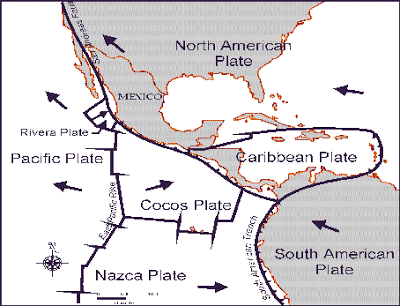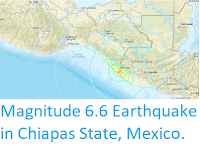Mount Popocatépetl, a stratovolcano (cone
shaped volcano made up of layers of ash and lava) in the central part of Mexico, has undergone a sharp increase in eruptive activity this week, according to the Centro Nacional de Prevención de Desastres. The volcano erupted 14 times between midnight and 7.15 am local time on Wednesday (2 October 2019), once on Thursday and three times on Friday. The Centro has issued a warning to the public not to approach the volcano, as there is thought to have been a significant build up of ash on its flanks, which could lead to lahars in the event of heavy rains, which are predicted in the area at this time of year.
Lahars are ash-laden flash floods associated with volcanoes. They can be
caused directly by volcanic eruptions, for example when hot lava
encounters a glacial lake rapidly destroying an ice dam, but are also
common in areas of high seasonal rainfall, where ash deposits from a
volcano can build up during the dry season, creating dams on seasonal
waterways, which temporarily halt the flow of water, then give way
rapidly leading to dramatic flash floods.
Popocatépetl has been more or less constantly erupting since the mid
1990s, but most of the time this activity remains at a low level. Major
eruptions on Popocatépetl are a cause for concern as the volcano
is in a densely populated area, with 30 million people living within the
potential hazard zone. The last major eruption, a Plinian (or Vesuvian)
event in about 800 AD, triggered a series of pyroclastic flows and
lahars that scoured the basins around the volcano.
The location of Popocatépetl. Google Maps.
The volcanoes of the Trans-Mexican Volcanic Belt (including
Popocatépetl) are fuelled by the subduction of the Cocos Plate beneath
the North American Plate along the Middle American Trench to the south
of Mexico. As the subducting plate sinks into the Earth it is melted by
the heat and pressure, and volatile minerals liquefy and rise through
the overlying North American Plate as magma, fuelling Mexico's volcanoes.
The subduction of the Cocos Plate beneath the North American Plate in Mexico, and how it leads to volcanoes and Earthquakes. King Saud University.
The Cocos Plate is thought to have formed about 23 million years ago,
when the Farallon Plate, an ancient tectonic plate underlying the East
Pacific, split in two, forming the Cocos Plate to the north and the
Nazca Plate to the south. Then, roughly 10 million years ago, the
northwesternmost part of the Cocos Plate split of to form the Rivera
Plate, south of Beja California.
The position of the Cocos, Nazca and Rivera Plates. MCEER/University at Buffalo.
In a paper published in the Journal of Geophysical Research, in 2012, a team led by Igor Stubailo of the Department of Earth and Space Sciences at the University of California Los Angeles, published a model of the subduction zone beneath Mexico using data from seismic monitoring stations belonging to the Mesoamerican Seismic Experiment, the Network of Autonomously Recording Seismographs, the USArray, Mapping the Rivera Subduction Zone and the Mexican Servicio Sismologico Nacional.
The seismic monitoring stations were able to monitor not just
Earthquakes in Mexico, but also Earthquakes in other parts of the world,
monitoring the rate at which compression waves from these quakes moved
through the rocks beneath Mexico, and how the structure of the rocks
altered the movement of these waves.
Based upon the results from these monitoring stations, Stubailo et al.
came to the conclusion that the Cocos Plate was split into two beneath
Mexico, and that the two plates are subducting at different angles, one
steep and one shallow. Since the rate at which a plate melts reflects
its depth within the Earth, the steeper angled plate melts much closer
to the subduction zone than the shallower angled plate, splitting the
Trans-Mexican Volcanic Belt into sections above the different segments
of the Cocos Plate, and causing it to apparently curve away from the
subduction zone.
Top
the new model of the Cocos Plate beneath Mexico, split into two
sections (A & B) subducting at differing angles. (C) Represents the
Rivera Plate, subducting at a steeper angle than either section of the
Cocos Plate. The Split between the two has been named the Orozco
Fracture Zone (OFZ) which is shown extended across the Cocos Plate; in
theory this might in future split the Cocos Plate into two segments
(though not on any human timescale). Bottom Left, the position of the
segments on a map of Mexico. Darker area is the Trans-Mexican
Volcanic Belt, orange circles are volcanoes, brown triangles are
seismic monitoring stations, yellow stars are major cities. Bottom
Right, an alternative model showing the subducting plate twisted but not
split. This did not fit the data. Stubailo et al. (2012).
Witness
accounts of Earthquakes can help geologists to understand these events,
and the structures that cause them. The international non-profit
organisation Earthquake Report is interested in hearing from people who may have felt this event; if you felt this quake then you can report it to Earthquake Report here.
See also...
Follow Sciency Thoughts on Facebook.











